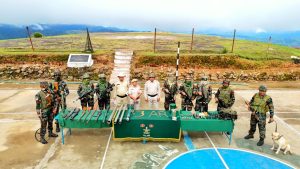The Indian government’s efforts to normalize the situation in conflict-ridden Manipur has met with limited success, revealing the deep and multi-layered faultlines in the border state that has been burning for almost two years.
Supreme Court Justice B R. Gavai, who had led a delegation of five Supreme Court judges as part of the National Legal Services Authority’s initiative to monitor efforts for supporting communities impacted by violence in Manipur, has described the situation in the state as a “difficult phase.”
Ethnic clashes erupted in Manipur on May 3, 2023. In the 22 months since, the violence has claimed around 250 lives and displaced nearly 60,000 people. Many of those displaced from their homes are lodged in relief camps. The government’s inability to check the violence has provoked sharp criticism from different quarters, including global organizations.
On February 13, Manipur’s Bharatiya Janata Party (BJP)-led government was suspended and President’s Rule (Federal Rule) was imposed.
Since then, the government has unleashed efforts aimed at making the state free from violence and restoring communication through roads that different communities engaged in the conflict blocked for several months.
However, even as vehicles began to ply the highway connecting Manipur to neighboring Nagaland, violence erupted in the Kuki-dominated Kangpokpi district on March 8, resulting in the death of one person and injuries to at least 20 others, including security forces personnel.
The Manipur Police said that a huge mob started pelting stones on a bus at Gamgiphai, and the security forces used “tear gas and minimum force” to disperse the mob. The protestors included women and children and there were incidents of firing from among the protesters towards the security forces.
The protests were in defiance of Union Home Minister Amit Shah’s directive for the resumption of movement of vehicles on all roads in Manipur. The protestors were insistent that their demand for a “separate administration” must be accepted before communication was restored.
Subsequently, a communal clash erupted in the Zomi-dominated Churachandpur district, where a man identified as Lalropui Pakhumate was killed and several others injured. The hostilities were sparked after some people made efforts to remove the flag of a Zomi armed group. Before the arrival of security forces in the affected locality, mobs and armed squads belonging to the Zomi and Hmar tribes fired shots and hurled stones at each other. The tense situation was brought under control after the police fired tear gas shells and several rounds in the air to disperse the mobs.
This episode marks a new chapter in Manipur’s conflict since it was a clash between two ethnic groups that were earlier united against the majority Meitei community. Intra-community conflict was also reported among the Meitei when members of two militant outfits — the Arambai Tenggol and the Pamhei faction of United National Liberation Front (UNLF) — clashed in Imphal East district, resulting in the arrest of six persons from both outfits a day after the incident. Efforts are on to apprehend other members involved in the violence.
These complexities notwithstanding, a modicum of success has been achieved in recovering the weapons looted from the police armories two years ago when the turmoil was at its peak. An estimated 6,000 weapons were looted at the time.
In late February, Governor Ajay Kumar Bhalla announced a two-week amnesty for the surrender of weapons. The amnesty, which ended on March 6, resulted in the return of a total of 1,044 arms and 14,779 rounds of ammunition. Among the surrendered weapons were locally made single-barrel rifles and improvised mortars that were not from the police armories. Officials are still ascertaining how many of these weapons belonged to the government.
Meanwhile, police, paramilitary and army personnel are continuing operations to recover the looted weapons, with seizures being reported at regular intervals. On March 23, the army recovered one INSAS rifle, one .303 rifle and one self-loading rifle (SLR) from Phaikot in the Senapati district.
The current state of affairs in Manipur is a stark reflection of the complexities of the conflict and the hurdles that exist to establishing normalcy in the disturbed border state. As is the case in all violent riots, the magnitude of violence has receded, but the divide is so wide and deep that it could take years to bridge.

































